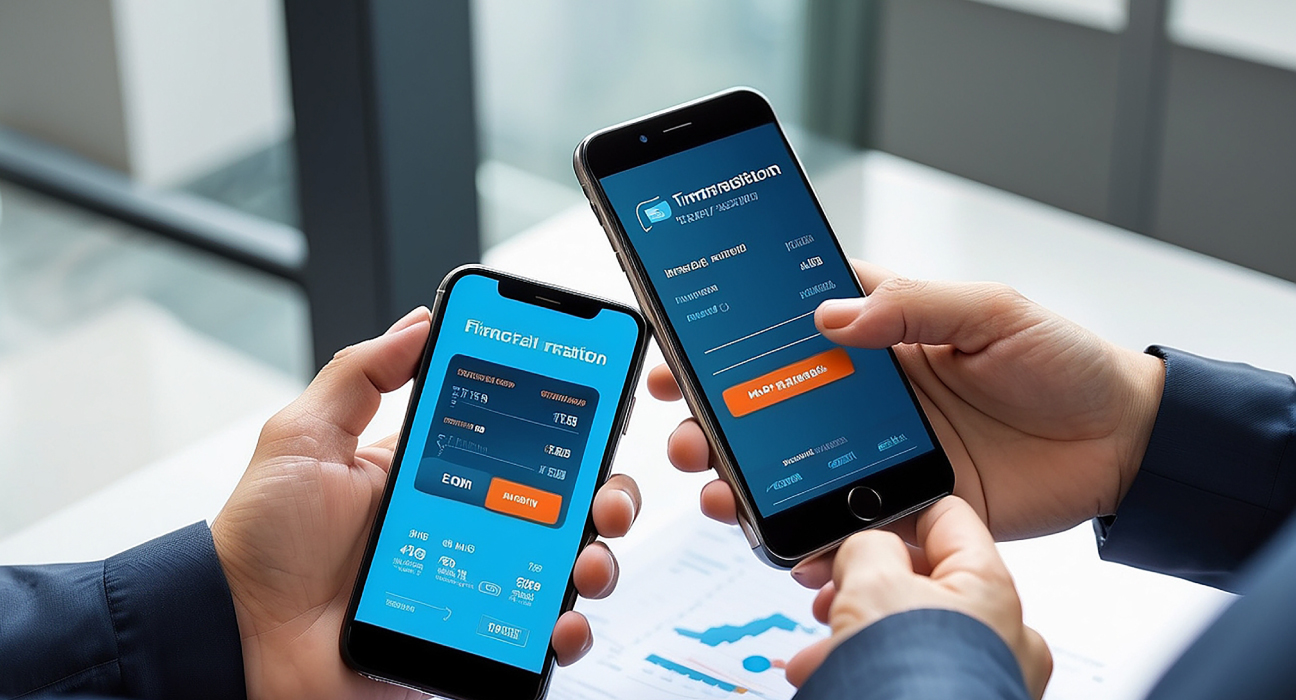How to Build a FinTech App in 2025

- Deval Patel

- Sep 19, 2025
The financial sector has undergone a shift in the past decade, and to a significant extent, most of these changes can be attributed to the emergence of financial technology, or FinTech.
FinTech has changed the flow and development of money, whether it is through the manner in which we shop for our groceries or how we save towards retirement. FinTech is not only an industry in 2025, but it is also the engine of the financial ecosystem of the new millennium, operating virtual banks, peer-to-peer payment systems, as well as decentralized finance (DeFi) and artificial intelligence-driven wealth management.
The contextual bridge to these innovative services has been created through FinTech apps, which have become the primary entry point for consumers and companies to the services. This impact is particularly decisive nowadays when individuals want quick, safe, individual, and mobile-centric financial services. To startups and entrepreneurs, the FinTech space provides a golden chance to innovate, grow in a short time, and develop sustainable streams of revenue.
In this blog, we will deconstruct the essentials of building a FinTech application in 2025. Regardless of your grasp of the market and ability to identify trends, selecting the appropriate tech stack, monetization approach, and development cycle, this step-by-step guide will take you through the most important steps to launch a successful and compliant FinTech product.
What is FinTech?
FinTech, an acronym of Financial Technology, is the application of technology to provide financial services in more efficient, quicker, and accessible methods, in contrast to the conventional systems. At first, the financial services sector was a preserve of physical banks and paper. However, the emergence of the internet, smartphones, and cloud computing has changed the nature of finance in a digital fashion.
Nowadays, FinTech covers a large ecosystem of products such as mobile payments, digital banking, peer-to-peer lending, investment and wealth management, insurance technology (InsurTech), personal finance management, and even cryptocurrencies. These platforms are based on the latest technologies, such as AI, machine learning, blockchain, big data, and biometrics, to achieve better security, lower costs, and make accessibility more convenient.
At its core, FinTech is about making finance simpler, smarter, and more inclusive, giving both individuals and businesses tools that were once reserved for institutions.
FinTech Market Overview
The current FinTech market in the world is increasing steeply in 2025. It is being estimated in the market that its valuation is above 340 billion with a likely rate of growth of 18-20% CAGR by the year 2030. North America and Europe are the most robust in terms of investment and uptake, whereas Asia-Pacific is the leader in mobile-first FinTech solutions and innovation.
This has been driven by the high penetration of smartphones, the adoption of digital-first financial transactions by younger generations, and the adoption of embedded finance into businesses. Millennials and Gen Z are the most prominent users, with the growing adoption of FinTech by small and medium enterprises (SMEs) to simplify the accounting, payment, and lending process.
Large entrants such as Stripe, PayPal, Ant Group, and Revolut have raised billions of venture funds, and additional new entrants are continuing to shake up legacy systems. As the regulatory authorities also adopt digital frameworks, FinTech is no longer an option, but rather the standard model of financial services.
FinTech Trends to Watch
There are a number of transformational trends that are defining FinTech in 2025:
- AI &Machine Learning: It can be applied in credit scoring, fraud detection, risk management, and personalized insights related to finances.
- Blockchain and DeFi: The future of transparent, safe, and decentralized financial systems outside the conventional banking system.
- Open Banking APIs: This is the ability of financial institutions to enable third-party applications to access secure data in order to provide improved services.
- Embedded Finance: The integration of financial services into non-financial platforms, e-commerce websites, and ride-hailing applications.
- Biometric Authentication and Cybersecurity: Enhancing user authentication by using facial recognition, fingerprints, and behavioral biometrics.
- Regulatory Technology (RegTech): is Compliance, reporting, and risk management done more quickly through automation of regulatory approval.
- Green FinTech: Advancing sustainable finance through the empowerment of carbon measurement, ethical investments, and payment systems that are environmentally friendly.
These trends are an indication of the direction in which innovation is going--and provide a roadmap upon which a startup can keep up.
FinTech Apps Monetization
To transform your FinTech concept into a business with high returns, monetization strategies are essential. Numerous applications implement the subscription approach, where there is a paywall to the more advanced options. Others have a freemium business model, which offers free basic services to users, with the development of premium tools later on.
It is typical to pay transaction fees when making payments and trading applications, and affiliate marketing and referrals are used to make apps earn off partner products, such as loans or credit cards. There are even platforms that capitalize on the monetization of data by providing anonymized financial insights to third parties- though this would always have to be in line with data privacy laws such as GDPR or CCPA.
The complexity of financial technologies FinTech applications, such as Robinhood (premium), Cash App (fee charges), and Chime (interchange), have demonstrated how various monetization plans can be successful provided that user trust and value delivery are the priorities.
Types of FinTech Apps
FinTech can be categorised into a number of segments, and knowing them will allow you to make the correct choice of niche:
- Digital Banking Apps: Banks that are mobile-first, i.e., provide savings, spending, and money transfer capabilities (e.g., neobanks).
- Investment Apps: A collection of investment applications enabling users to make investments in stocks, ETFs, and crypto, among others.
- Personal Finance Management Apps: Budgeting, goal tracking, and spending analytics.
- Payment & Money transfer Apps: Instant peer-to-peer or cross-border transfers are made possible.
- Insurance (InsurTech) Apps: On-demand, AI-powered Insurance Policy Management and Claims.
- Lending Platforms: P2P loans, Buy Now Pay Later (BNPL), and small business loans.
- Cryptocurrency Wallets & Exchanges: Support safe crypto-trading and storage.
- Niche FinTech: Apps that target a particular group of users, such as students, SMBs, or gig workers.
The types are applicable to the different user needs and regulatory settings; therefore, select one that fits your target market.
Top 6 FinTech Apps in 2025
1. Revolut
It is now a multi-currency account provider with budgeting features, crypto trading, and low-cost international transfers worldwide. It has a freemium business model, which allows its users to get basic banking at no cost, but provides improved services with premium subscriptions. It is easy to use, has a worldwide presence, and possesses a unique capability that ensures smooth cross-border financing.
2. Robinhood
It will be among the best investment and trading applications in 2025, as it will be used by successful millennials and Gen Z investors. It enables trading of stocks and crypto without a commission fee and generates revenue by accepting payment of order flow and premium subscriptions, such as Robinhood Gold. Gamified interface and learning tools of the app have opened up the investment world better than ever.
3. Chime
Chime has reinvented mobile banking through no-fee accounts, early direct deposits, and automatic savings. Its income is primarily based on the payment of interchange fees on debit cards. The success of Chime is founded on the trust of its users, openness, and functions that make money management manageable by ordinary people.
4. Cash App
This unites peer-to-peer transfers, banking, stock investment, and Bitcoin trading in a single app. It makes its revenue via instant transfer charges, Bitcoin trade, and Cash Card interchange charges. This is due to the clean design and all-in-one focus of the app that attracts millions of active users.
5. Lemonade
Lemonade has transformed the insurance market through an AI platform that has simplified the administration of the policy and claims. It is offering flat monthly rates and giving the unclaimed premiums to social causes, which promotes trust and brand loyalty. Its combination of automation, transparency, and social impact attracts younger and tech-savvy users.
6. Coinbase
Coinbase still reigns in the crypto ecosystem with the provision of safe cryptocurrency purchases, sales, staking, and wallets. Its revenue comes in as a result of trading fees and institutional custody services. Coinbase continues to be the destination of choice among crypto fans and institutions because of its high regulatory compliance and a solid security system.
Features required in FinTech Applications.
FinTech applications have to be convenient and secure. Some key features include:
- User Onboarding & KYC: Smooth registration and built-in identity verification.
- Secure Authentication: There should be Biometrics, MFA, and encryption to secure the user data.
- Real-Time Notifications: Notifications on transactions, spending limits, and suspicious activity.
- Transaction History and Analytics: Comprehensive record keeping and spending in a category.
- Connection with Bank Accounts: The cards and external accounts can be connected seamlessly.
- AI-Powered Recommendations: Recommendations of a budget, investment guidance, or even warnings about risks.
- Customer Care: Chatbots and human operators to solve an issue fast.
- Built-in regulatory Compliance: Tools for GDPR, PCI DSS, and AML/KYC.
A classic FinTech architecture consists of a safe client application, API gateway, micro-services back end, information store, and third-party integrations.
The process of making a FinTech app in 5 steps
Step 1: Market Research and Compliance Research
Begin by determining who your target market will be, the monetary touch of your target market, and selecting your niche in the market- payments, budgeting, lending, or investing. At the same time, go through the financial regulations of your target countries because the design and development strategy will be influenced by regulatory mechanisms such as PCI DSS, KYC, and AML.
Step 2: UX/UI design
In finance, trust of the user is all. Your design must be elegant, usable, and plain. Ensure uniform visual representation, drag queuing, and straightforward navigation to make the users feel secure. Developing trust also implies emphasizing security measures and privacy guarantees through the interface.
Step 3: Develop the MVP
Target the basic functionality. Create a minimum viable product (MVP) that addresses the most urgent issue of your users. This process accelerates time-to-market, assists in collecting feedback earlier, and decreases the chances of overbuilding until product-market fit has been established.
Step 4: Introduce Security and Compliance.
Inculcate security in all levels of development. Use data encryption, application of secure authentication procedures, such as biometrics and MFA, KYC verification, and detection of fraud. Make sure that you comply with such laws as GDPR, PCI DSS, and SOC 2 to establish long-term trust.
Step 5: Launch, Monitor & Iterate
Once your MVP is launched, do intensive testing, collect analytics, and the KPI such as retention and churn. Fix bugs, implement the enhancements, and step by step add the features as the users provide feedback. With an iterative approach, there will be constant growth and satisfaction among the users.
Cost of FinTech App Development
App features
This is determined by the complexity of the app, features included, platforms compatible (iOS, Android, web), and the geographical location of your team. To illustrate this, a team in North America or Western Europe is more expensive than a team in Asia or Eastern Europe, and any advanced technologies, such as AI analytics or blockchain, will contribute to the budget.
Compliance and Security Costs
Financial applications have to follow stringent regulations. The implementation of security measures such as encryption, multi-factor authentication, anti-fraud, and legal audits would add additional cost factors, but are essential to earn user trust and fulfill industry requirements.
MVP vs Full-Scale App
The necessary features needed in a minimal viable product (MVP) are easily reached at a range of 50,000-80,000, and may require a span of three to six months to develop. A full-scale, fully functional FinTech application, including complex infrastructure and full security, can be more than half a million dollars and require nine months or more to develop, by contrast.
Development Timeline
Different timeframes are based on the scope and complexity. Small MVPs are cheaper and quicker to develop, whereas large-scale apps used in FinTech will take more time to develop and test performance, security, and compliance before being deployed.
Conclusion
FinTech is no longer a disruptive element in that it has become the new reality of financial services, and it has transformed the way individuals save, spend, borrow, and invest. With the ever-growing pace of this industry, 2025 is huge with regard to the visionary founders who wish to be innovative and create sustainable value.
The key to success is to aim to establish user trust, integrate security and compliance at the very beginning, and to use an agile approach that will allow responding to market feedback. Keep in mind, not only about the launch of a product, but also about the establishment of a safe, trustworthy, and convenient financial experience.
Ouranos Technologies can assist in making your FinTech a reality if you are willing to make it a reality. Contact us now and begin developing your FinTech application and be the first to create the future of finance.

Latest Articles
Browse All Articles
- Other
- Nov 12, 2025
AI in Automotive Industry: Benefits, Use Cases & What's Next
Discover how AI is transforming the automotive industry, from smarter manufacturing and predictive maintenance to autonomous driving and connected vehicles.

- Other
- Nov 11, 2025
How AI is Reshaping ERP: Challenges, Opportunities, and Key Trends
Discover how AI is changing ERP, from smarter automation to predictive insights and business efficiency.



